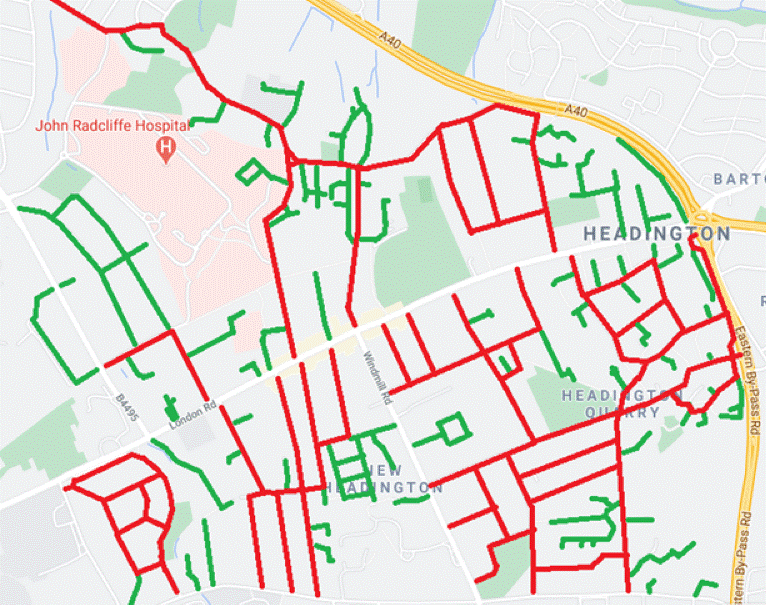Mind the gap – why Low Traffic Neighbourhoods are being trialled in Headington

Although they’ve only made the headlines recently, Low Traffic Neighbourhoods (LTNs) are nothing new and much of Oxford’s road network is already designed that way, exposing the gaps in-between.
Some of these existing LTNs were purpose-built and some have been ‘retro-fitted’ with filters to prevent problematic through-traffic. They’re accepted as standard practice in most new housing estates. This is the case in Headington and many other parts of Oxford.
However, a look at the existing LTNs in and around Headington reveals “gaps” that make those side streets of central Headington that remain open to through-traffic dangerous, unpleasant and difficult to get around by foot, mobility aid or bike (active travel):
This map highlights a similiar issue in Cowley and East Oxford.
The problem is, these black spots aren’t just the result of short-cutting traffic; they’re also a generator of more traffic. Many people living in or travelling through these areas are less inclined to walk, wheel or cycle their journeys because the minor roads they have to use aren’t equipped to cope with today’s levels of motor traffic. They have to contend with road danger from speeding vehicles, narrow, parked-on pavements, a lack of safe crossing places and dropped kerbs, poor visibility between parked cars and so on on their daily journeys, so many opt to drive instead, in turn adding to the traffic on the surrounding major roads.
But this isn’t only a problem for people living in the short-cutting areas themselves or on the major roads surrounding them: it also means many people living in the neighbourhoods immediately next to Headington aren’t inclined to walk, wheel or bike to or through it either, and also feel safer travelling by car.
The trouble is, neither are people travelling to or through Headington from elsewhere in the city and county. For example, some people who might otherwise consider Park & Pedal from Thornhill to the hospitals (a distance of less than 2 miles in each case), are also put off doing the last leg of their journey by bike. So they too are more inclined to drive, further increasing the traffic levels in Headington’s neighbouring areas on their way through.
Traffic isn’t a force of nature and doesn’t come exclusively from outside the area; it’s you and me and the cumulation of the conscious and sub-conscious choices we make when weighing up the easiest, most pleasant way to go about our everyday journeys, especially our short, local journeys. We follow the path of least resistance.
For every person who can’t or won’t choose a different option to driving, there’s at least one person who’d love to! The first lockdown showed us that.
That person might be your neighbour and, if more travel options are open to them, that might just mean one less car in front of you next time you need to take yours.
So, if you’re new to the topic of LTNs and can’t see the logic of how they reduce traffic overall, think of it like this:
If you can walk, wheel or cycle all of your journeys, do that.
If you can walk, wheel or cycle some of your journeys, do that.
If you can’t walk, wheel or cycle any of your journeys, support measures that enable others to [1]
In this way, we all play a part in reducing the traffic problems around our area – for our own benefit and that of our neighbours.
More more questions about LTNs? Visit our FAQs.
[1] Sarah Berry, new cyclist and active travel advocate
Oxford’s traffic issues are far from unique. LTN trials are underway in many neighbourhoods around the country that face similar problems to Headington. The following thread about the Oval LTN in Lambeth summarises how the trial is progressing there. Full report available here.
We always said that the Oval #LTN would transform our neighbourhood for the better.
— SaveOvalStreets (@SaveOvalStreets) September 7, 2021
And now the data bears that out....
Traffic within the LTN & on boundary roads ⬇️ 8%
Traffic within the LTN ⬇️ 25%
Traffic on boundary roads ⬇️ 2%https://t.co/zybldGogWK pic.twitter.com/CR0ZUrb9Lx
